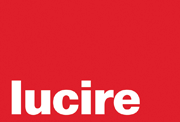|
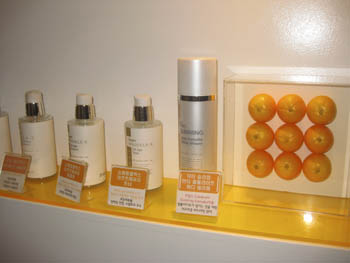
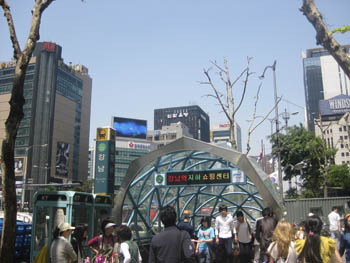
THE KOREAN TOURISM
ORGANIZATION’S
global campaign is brilliantly summed up in one word: sparkling.
On one hand, Koreans know a thing or two about effective
branding. In larger cities, shopping areas are ablaze with the world’s
great designer and high-street brands, from Armani to Zara, all
grappling for the hearts and minds of a supremely stylish population.
Asian labels, such as Ralph Lauren-esque Bean Pole and Armani Exchange-ish
Giordano, thrive because they know what modern Koreans want: western
chic with a flair that is still very definitively Korean and unquestionably
upscale. On the other, Korea has a rich history to draw upon.
Reinforcing Korea’s “sparkling” brand-building efforts
is a king’s ransom of phone-book sized glossy lifestyle, fashion
and wedding magazines (such as Heren) that are selling ads
and finding readers, even as many of their western counterparts
are shutting down or cutting back. Fashionistas need not need to
know how to read or speak Korean to intuit Koreans want to present
their country as an enchanted place where there is seemingly no
recession and everybody can live life to the fullest. For history
buffs, however, Korea is a complexly sparkling gem that rose from
a tumultuous history to emerge as one of the most progressive countries
in terms of technology, commerce and lifestyle—especially from
1988 forward, when Seoul hit the world stage when it hosted the
Olympic Games.
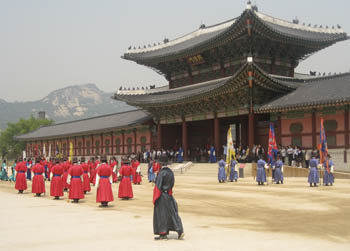
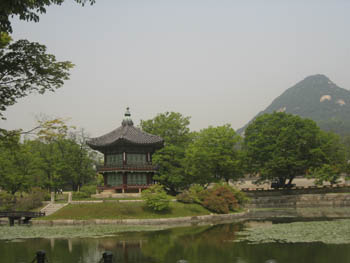
Seoul, currently ranked the world’s second largest metropolitan
area, is a dazzling maze of gravity-defying skyscrapers, neon and
winding highways best showcased at night. However, the soul of Seoul
can be found by day within that maze, via the many temples and palaces
that can be found in every corner. They are laid out and preserved
so effectively that stepping onto the grounds is almost like
stepping back in time.
Bosingak Bell Pavilion, Jogyesa Temple and the complex
housing the Gyeongbokgung Palace, National Folk Museum of Korea
and National Palace Museum of Korea are full-on cultural
immersions into Korean history, anthropology, landscape and architecture,
where the modern skyline of Seoul almost seems to vanish.
The North Seoul Tower and its surrounding park, meanwhile,
offer a graceful look at modern urban recreation at its best. However,
both experiences bolstered with both subtle and evident modern creature
comforts, as well as above average shopping opportunities.
While the North Seoul Tower’s souvenir boutiques offered
an impressive mix of kitschy (fun airbrush-painted passport covers
adorned with the Tower and ethereal cats) and classy offerings (i.e.
delicate sterling silver jewellery by Special Hands), my stunning
Seoul-based English language guide, Sharon Choi, advised me to not
leap at the first thing I saw, though I bought a Special Hands pendant
anyway. She, of course, was right. When it comes to shopping, a
sensory overdose is a very real possibility for even the most seasoned
hard-core fashionista.
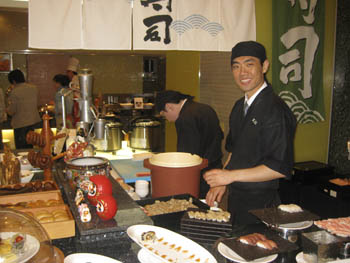
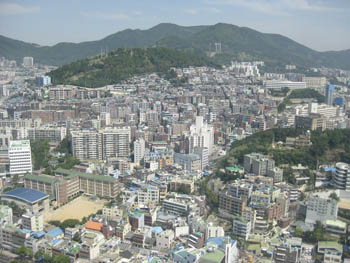
Seoul offers everything from chaotically colourful open-air
flea markets near local universities (Yonsei and Hongig), to trendy,
crowded chain-store vendor-lined shopping streets of Myeong-Dong,
Namdaemun and Dongdaemun for reasonably priced fast fashion that
this year is leaning towards a very preppy æsthetic.
Those with more upscale tastes and deeper pockets, whose
standards are shaped by department stores Harvey Nichols, Neiman-Marcus,
Bergdorf Goodman, Lane Crawford or Galleries Lafayette, will be
impressed with Shinsigae, which spins its luxury-crammed departments
and floors to dizzying heights. Lotte, which one will quickly realize
is the ultimate national brand, has its name on department stores
that are akin to Macy’s or David Jones, mixing high end and more
moderately priced labels.
Seoul is also home to Coex, one of the world’s great
megamalls that visually and contextually takes the entertainment–shopping–family
recreation–dining experience to ultra-modern extremes. One
of the best hotels on Jeju Island also bears the Lotte name, as
well as an adorable gift shop with some hidden (affordable) jewellery
treasures and a quirky free-standing branch of Louis Vuiton.
After cruising the consumer-driven concourses and lanes,
however, I was pleased to realize Sharon and I were very similar
not only in our tastes in fashion (she scours Banana Republic when
visiting North America), but also our style of shopping:
admiring high-end labels and quality, and preferring stores focused
on either classics or great one-off pieces. However, given our similar
careers, we also have similar limitations on our annual clothing
budgets.
Intuitively, Sharon knew her favourite haunts were going
to strike a chord with me. After a morning of appreciating Jogyesa
and other temples, she figured I would be inspired by the gallery-lined
Insadong shopping street and the positively charming Ssamziegil,
a relatively small shopping centre with a design inspired by artisan
villages from earlier times. The merchandise itself, however, is
as appealing to anybody with 21st century sensibility seeking head-turning
accessories and home accents.
Just steps from the mini-mall, however, Sharon and I
scored intricate hand-crafted earrings from Gu Pil Seo (1F, 169-2,
Gwanhun-Dong), that deftly blends antique-y silver accents from
old Korean royalty and semi-precious stones hewn into modern shapes.
From Sharon’s point of view, however, there is no better
shopping haven than Doota, essentially
Willy Wonka’s Chocolate Factory but with clothing, bags, sunglasses
and shoes replacing the different forms of chocolate and novelty
candy. For Sharon, Doota represents the most complete shopping
experience, incorporating the perfect blend of western and Korean
fashion influences, good quality, reasonable prices and tailoring
that is spot on for career women over 25 and under 50. Though Shinsegae
was label heaven, I could have easily spent a day perusing every
micro boutique on every floor of Doota.
Given our time was limited (as there was another sumptuous
temple and an equally lavish buffet dinner waiting), we scored lovely
linen tunics at They International and summer bottoms from [Pa]:Plus
for a mere US$25 per piece and comfy-but-fashion
forward sandals from Ficce Design Studio.
After several hours of shopping and dining out at some
of Seoul’s more fashionable establishments, it’s easy to find the
uniform of young Korean women irresistable: ultra-feminine, defined
by ruffles, bows, lace trims and flowing fabrics, whether the individual
prefers a clean preppy look, a girly ladies-who-lunch look or something
more edgy and modern. That said, the honest truth is that this look
does not always work head-to-toe on curvier figures (like my imposing
5 ft 8 in, size 10 US frame). More
frustrating still, sizes are limited (though many of Doota’s offerings
were forgiving and more generous with larger and European sizes).
When it comes to skin care products and treatments,
however, there is happily something for everybody to take home and
enjoy. Sharon introduced me and my enthusiastic Brazilian colleagues
to the Story of Whoo and its younger sister brand O’Hui, both offering
sunscreen products that were at once luxuriant and state-of-the-art.
However, with Korea as a noted international centre
for day spa, medi-spa and cosmetic surgery innovation, other guides
from the KTO noted many visitors have
come to Seoul for more permanent souvenirs.
To give us a taste of the country’s emerging beauty–cosmetic
tourism segment, we were bee-lined soon after our arrival in Korea
to Seoul’s Anacli Centre, widely acclaimed for its treatments and
private-label anti-ageing skin care products for men and women.
Though the centre was nicely appointed, and had plenty of free copies
of Heren to pour over in the waiting room, the treatments
were relaxing, simple and administered by calm, attentive practictioners—exactly
what you’d want after an 11-plus-hour flight. Though I indulged
in my stash of O’Hui powder sunscreen at the glamorous Busan branch
of Shinsegae, my Brazilian fellow travelers wisely waited until
they hit the duty-free.
Though one cannot totally escape the siren call of Seoul’s
buffet of labels and luxury shopping, experiencing Busan and Jeju-Do
offer wonderfully laid-back facets of the Korean lifestyle as well
as spectacular scenery and cultural offerings very different from
Seoul’s cosmopolitan sprawl. Plus, getting to Busan gives one an
excuse to ride the real life KTX “Seoul
Train”, which includes panoramic views, cookies and unlimited wifi
in the first-class section seats for a few extra dollars.
Busan has its beachy and remarkably international aspects
(Germans, Americans, New Zealanders and Australians intermixed freely
with locals at Haenundae Beach—something Sharon was quite pleasantly
surprised by; the UN Cemetery and
war memorials) as well as a well-appointed shopping district (anchored
by Lotte and Shinsegae). However, the real centre of interest is
the Jagalchi Fish Market and downtown streets more commonly
frequented by locals (where my Brazilian friends found true bargains
on their favourite athletic shoe and clothing brands, in colour
combinations very different from what they could get at home, and
I snagged an organic cotton tunic from the local branch of Dolsilnai,
a “traditional” chain of clothing stories now looking for younger
customers).
Jeju-Do, even with patches of in-your-face romance engineered
for the bustling Korean wedding and honeymoon markets and well-heeled
families with young kids, is a lovely breath of fresh air. What’s
most memorable about the UNESCO Heritage-certified
site island are its wide-open rural spaces, heavenly stretches of
coastline, agricultural flavour and an intoxicating smell of jasmine
in bloom and citrus that permeates the entire island.
There are also many ways visitors can experience Love,
Korean Style. It’s fun to see that so many Korean newlyweds
so committed to one another, they even sport colour-coordinated
or identical outfits. Most Korean films shot in Jeju are love stories,
and markers indicate the spots were key scenes were shot so newly
married fans can create their own Kodak moments. However, so many
park areas are so breathtaking, all visiting couples will need is
their sense of adventure at such places as Chonjiyeon Waterfalls,
and the Yongmeori Coast.
While the Lotte Resort puts travellers, honeymooning
or otherwise, in the lap of over-the-top east-meets-west luxury,
Shilla offers a more modern and subdued form of five-star glamour.
The Hyatt is old school Hyatt (down to its airy 1970s trademark
atrium) accessorized with 21st century amenities. Visitors also
have the option of staying in authentic pension-style accommodations,
as well as venturing away from their comfy rooms for rich cultural
and natural highs–from Chung Gye Chang Stream and Yongsuam Rock
and a rigorous hike up to Seongsan Ilchulbong (Sunset Peak) to the
O’Sulloc Tea Museum (Sharon recommends the soft-serve green tea
ice cream, while our Brazilian friends loved the boutique stocked
with wonderfully packaged, nicely priced exotic teas and skin-care
products) to a vibrant collection of art galleries and cultural
museums such as the Folk and Natural History Museum.
In presenting its best face to the outside, the KTO
and Korea’s hospitality industry tap effectively into a culture
that is now a masterful blend of history and modernism. However,
to fully appreciate these efforts, like Dr Moon and his team at
the Anacli Clinic, you have to look below the surface to get a real
sense of Korea’s value on quality of life. It’s not just found in
hotels, restaurants and stores, but also in the meticulous attention
to cleanliness in many public spaces, to friendliness of people
on the street to the futuristic Incheon Airport (see right column).
Though we all may have differences of opinion of how
important luxury is, living well is an absolute necessity, and seeing
that mindset in action is fascinating. •
For more information, visit www.visitkorea.or.kr
and www.koreanair.com.
|  |
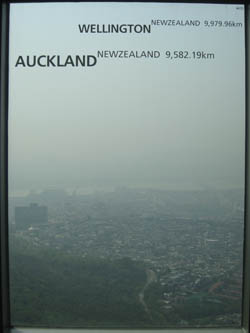
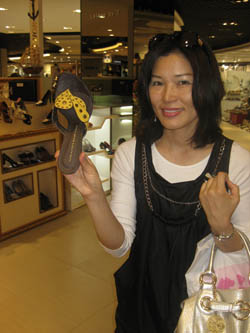
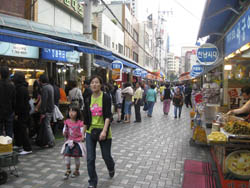
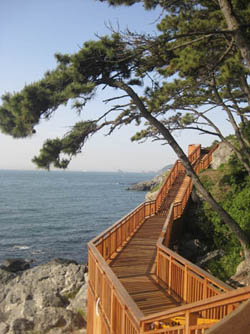
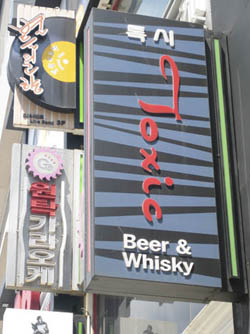
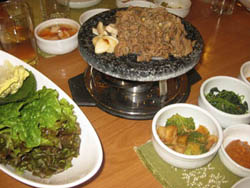
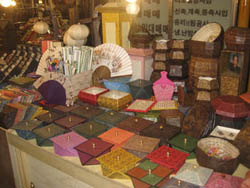
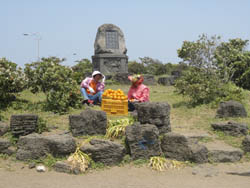
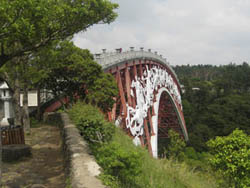
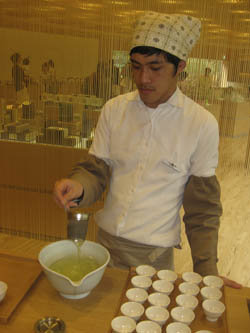
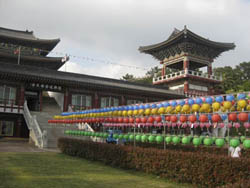
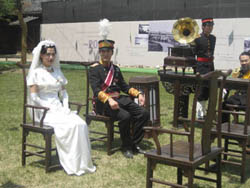
Incheon International Airport: the only way to pre-fly
Elyse Glickman is US West Coast editor of Lucire.
|
